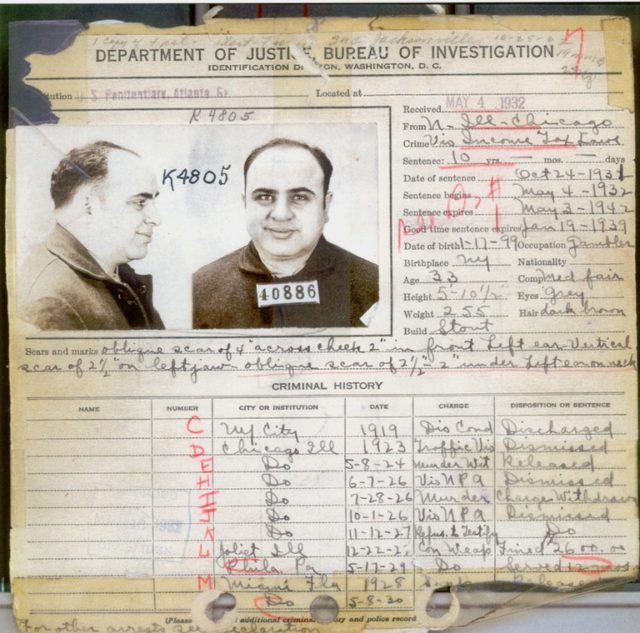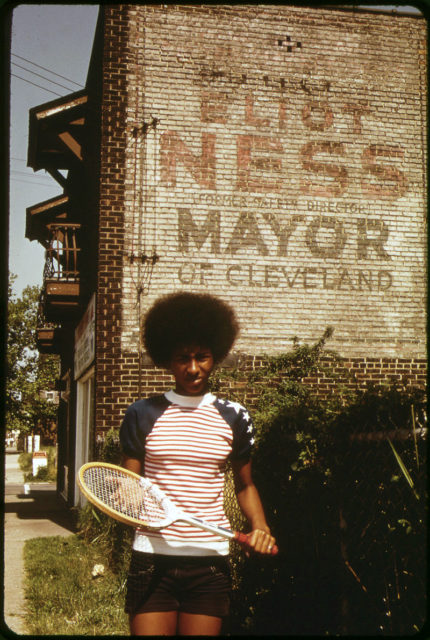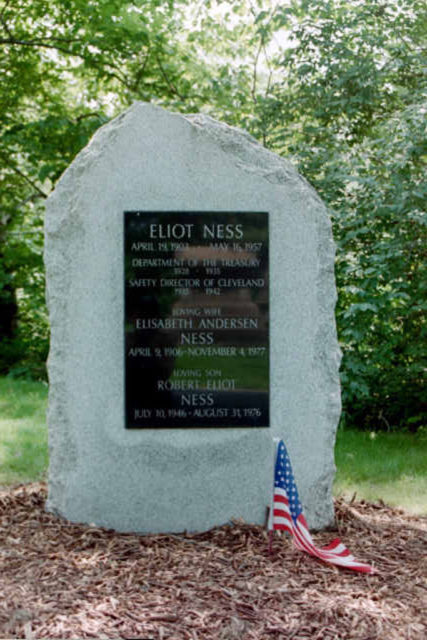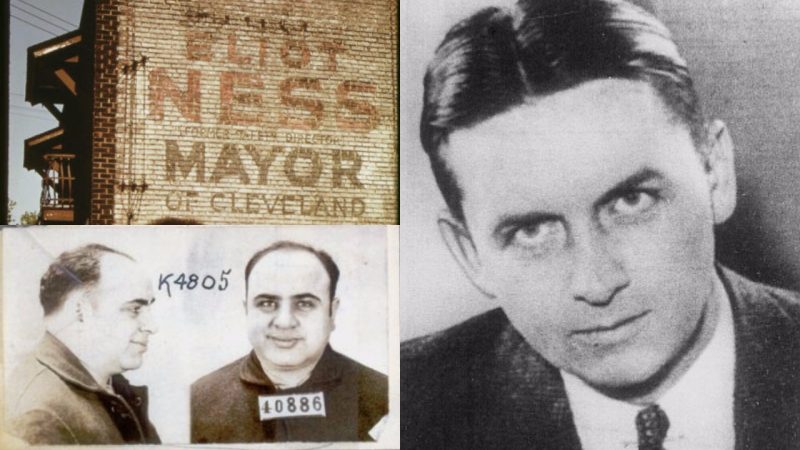Romanticized in countless gangster movies and novels, Chicago’s corrupt and lawless past holds a special place in American history. Organized crime in this city dates back to the 19th century, but its period of glory was the era of Prohibition, when Al Capone, America’s best-known gangster, established himself as the head of the most profitable crime syndicate of the time and went on to become known as Public Enemy Number One.
The scar-faced mobster ruled an empire of crime in Chicago and, according to the FBI archives, he was involved in “gambling, prostitution, bootlegging, bribery, narcotics trafficking, robbery, protection rackets, and murder.” However, Capone bought legal immunity by bribing police officers, politicians, and judges, which put him in a position above the law.
There were few law enforcers who weren’t bribed in one way or another, and this had to be easy for Capone, who allegedly earned over $100 million per year at the peak of his criminal activities. However, there was one man he simply couldn’t bribe and it was this man who brought Capone down and put an end to corruption in Chicago. His name was Eliot Ness.

Ness started off his career as a relatively unknown government agent and went on to become one of the most famous federal agents in the United States. The Bureau of Alcohol, Tobacco, Firearms and Explosives described him as “a supervisor of an ordinary team of agents who did the extraordinary,” and there is a damn good explanation for this flattering description of Ness and his colleagues, as they are considered responsible for the fall of Al Capone, the most notorious gangster in Prohibition America.
Bringing down one of the most powerful men in America at the time seemed like an impossible task, yet the relatively young agent was prepared to step forward and risk not just his life or the lives of his colleagues, but also the lives of his and their beloved families in order to put Al “Scarface” Capone behind bars.

Hundreds of breweries and distilleries were controlled by Capone at the time, who was also responsible for the illegal importation of a considerable amount of alcohol from Canada and other countries. Thousands of people caught up in the misery of the Great Depression worked for the notorious mobster, whose network of breweries and distilleries in Chicago was practically impregnable, but agent Eliot Ness was about to change all this.
Ness and his team of agents took part in numerous raids of Capone’s breweries, always leaving their mark by smashing many of the precious barrels. In no time they gained a reputation for being fearless and non-corrupt law enforcers determined to go all the way until organized crime in Chicago was fully exposed and destroyed.

Al Capone had to do something to stop Ness and his team. He tried to bribe them, but he soon found out that Ness was nothing like the law enforcers he had dealt with before, as he refused the money without thinking twice. Due to their firm position, a newspaper columnist called Ness and his team “the Untouchables,” a nickname that director Brian De Palma would adopt for his 1987 movie in which Eliot Ness (portrayed by Kevin Costner) would heroically take down the mobster.
However, according to Douglas Perry’s biography of Eliot Ness, there are certain parts of De Palma’s movie that aren’t based in reality, and one of them was Ness’s personal purity–Ness was a heavy drinker and womanizer. Another interesting detail about Ness and the Untouchables is that not everyone in Ness’s team refused to be bribed by Capone. According to an article written by David Leafe and published by the Daily Mail back in 2014, Ness “knew that at least one of the men in his squad had accepted bribes from Capone but he chose to turn a blind eye.” Nonetheless, Ness was unquestionably incorruptible, and it was his honesty that motivated the bureau to form a team of men to take on Capone.

Prohibition agents at the time were among the most corrupt officials, and it is believed that over 700 were fired between the years of 1921 and 1928 and nearly 300 prosecuted for bribes. To make things worse for the bureau, it was estimated that over 100 of the 300 Chicago area agents were on Capone’s payroll, which meant that forming a special squad was quite a struggle for the bureau.

As written in Steven Nickel’s Torso: The Story of Eliot Ness and the Search for a Psychopathic Killer, Ness’s file stated that he displayed “coolness, aggressiveness, and fearlessness in raids, that he had far more than the average number of arrests and that he didn’t shirk assignments or complain about extra hours.” The bureau informed him that he had been selected as the leader of the complicated task in September 1929 and soon he started selecting his men.
Hundreds of files of agents passed through his hands, but in the end, he settled upon nine. Martin Lahart, Samuel Seager, Lyle Chapman, Barney Cloonan, and Thomas Friel were Chicago agents and the other four agents were selected for their particular talents and skills. Paul Robsky, a wiretap expert; Michael King, tailing suspects expert; William Gardner, undercover expert; and Joseph Leeson, driving expert.

King’s skills were used to track down Capone’s breweries and the team launched the raids that would eventually result in a failed attempt to bribe agent Ness, who refused an offer that matched his annual salary at the bureau. Left with no other options, Capone turned his attention to the rest of the Untouchables, harassing them and their families. As written in Douglas Perry’s Eliot Ness: The Rise and Fall of an American Hero, “the Mob stole their cars and abandoned them miles away. It spread rumors about them. It called the Prohibition Bureau office and threatened whoever answered the phone. Gangsters began tailing the agents and hanging around outside their homes. I remember twice Ness and I drove fast to my apartment when my wife reported hoods were outside and she was scared.”
In a period of just six months, the Untouchables had enough evidence to indict Capone and his associates on 5,000 Prohibition-related offenses. However, the criminal evidence that sent Capone to jail was not produced by the Untouchables, but by the Treasury Department and Justice Department officials. Capone was instead found guilty of tax evasion and was sentenced to serve 11 years in Alcatraz.

It was 1932 when agent Eliot Ness was informed that one of the Chicago agents in the Untouchables, Barney Cloonan, was actually bribed on several occasions by Capone. It was a devastating news for Ness, but he decided not to take action, fearing that it would ruin the fine reputation his team once enjoyed.
He became Cleveland’s Public Safety Director in 1935 and battled against corruption and inefficiency in the police department, but his success was overshadowed by the scandalous divorce from his first wife, Edna, following his numerous love affairs. He liked drinking since the glorious days in Chicago, but the divorce made him a very heavy drinker and he frequently visited nightclubs, which is where he met his second wife, Evaline McAndrew.
Things grew worse for Ness when he had to resign his job after a newspaper revealed that he tried to hush up a car accident. In 1944 Evaline began an affair and left him. Ness married again, in 1946 to a sculptress named Betty, with whom he spent the rest of his life.

His life was about to change after journalist Oscar Fraley offered to ghost-write his life story, but he died before the book was published. The book proved to be extremely inaccurate, as Fraley made up most of it, but it captured the imagination of Hollywood, which led to the creation of two television series and a movie.
Read another story from us: The mystery of Al Capone’s vaults
“Broke, alcoholic, and dead from a massive heart attack at just fifty-five.” This is how Douglas Perry describes the final moments of Ness’s life. He adds that “few newspapers bothered publishing an obituary.” Agent Eliot Ness remained a largely forgotten figure for quite a long time before Hollywood took up Fraley’s made up story about his life and made him the legend he is today.
The true story about Ness faded into history, but if not anything else, one thing he should be remembered for is this: he was one of the few men Al “Scarface” Capone couldn’t bribe.
